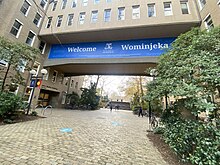Australia ranked third in top study abroad destinations with a total market value of over 5 billion AUD (3.47 billion USD) generated by international students in 2018.[1] In 2023, 786,891 international students were enrolled in educational programs in Australia, which was 27% higher than the previous year. In 2024 this is forecasted to increase again by 18%.[2] They come to gain a high-quality education, possibly immigrate, or to experience a different life. Each year, many new international students will enrol in Australian courses and add to the already significant international student body around the country.

Australia has the highest ratio of international students per capita in the world by a large margin.[3] In 2019, international students represented an average 26.7% of the student body population in Australian universities. International education therefore represents one of the country's largest exports and has a pronounced influence on the country's demographics, with a significant proportion of international students remaining in Australia after graduation on various skill and employment visas.[4]
Australia has by far the highest percentage of international students in the world, relative to total population[3], with 1 international student per 33.6 people in 2023 (786,891 students[2], 26.45 million residents). If the 18% growth seen in 2024 continues[2], this number will increase to 1 in 28.8 (3.48% of the population).
According to data released by the Departure of Education and Training of the Australian Government in 2023, China is the most significant source of international students to Australia. India had the second largest proportion of the enrollments, followed by Nepal, Colombia and Philippines.[5]
All international students are required to obtain a valid student visa before they arrive in Australia.[6] When students apply for their student visa through the Department of Home Affairs of the Australian Government, they need to submit the electronic Confirmation of Enrolment (CoE) and a compulsory English language proficiency test score to lodge their visa application. Also, each student visa applicant must prove that they have enough financial ability to pay for their tuition fees, books and daily living expenses while they study in Australia.[7]
After the Australian government published the new immigration policy, international students are encouraged to study, work and stay in regional areas in Australia, such as Adelaide, Tasmania and the Northern Territory.[8] In order to protect the local workforce, the Australian government intends to reduce the number of accepted migrants, and in the long-term, the government aims to set the cap of skilled immigration to about 160,000.[9]
In 2023, according to the Department of Education of the Australian Government, New South Wales, Victoria and Queensland are the states attracting the largest portion of international students.[2]
- ^ "Top 9 Countries With the Highest Investments in University Education - MastersPortal.com". www.mastersportal.com. Retrieved 24 May 2019.
- ^ a b c d Cite error: The named reference
:32was invoked but never defined (see the help page). - ^ a b "Australian universities double down on international students - MacroBusiness".
- ^ "Record number of international students sticking around on visas with full work rights - ABC News". Australian Broadcasting Corporation.
- ^ "International students in Australia". Studies in Australia. Retrieved 24 May 2019.
- ^ Cite error: The named reference
:17was invoked but never defined (see the help page). - ^ Cite error: The named reference
:7was invoked but never defined (see the help page). - ^ "Postcodes of regional Australia and low population growth metropolitan areas". immi.homeaffairs.gov.au. Retrieved 24 May 2019.
- ^ Cite error: The named reference
:0was invoked but never defined (see the help page).